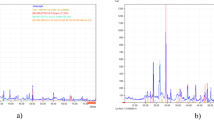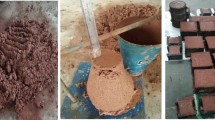Abstract
The property of asphalt mastic directly affects the service performance of asphalt mixtures and pavements. Previous studies have demonstrated that the interaction between asphalt binder and mineral fillers has a significant effect on the performance of asphalt mastics. However, the interaction hasn’t been characterized by direct tests. In this study, an adsorption–separation test of asphalt binder on surface of mineral fillers was conducted to separate the structure asphalt binder and free asphalt binder. Atomic force microscope (AFM) PeakForce QNM mode was used to characterize the morphology and mechanical property of asphalt binder at different distances to filler surface. Results show that the effected thickness of binder–filler interaction was around 1 μm. Within this specific thickness, the “bee” structure of asphalt surface disappears gradually, and the modulus increases significantly when the tested samples are closer to the aggregate surface.










Similar content being viewed by others
References
Anderson DA, Bahia HU, Dongre R (1992) Rheological properties of mineral filler-asphalt mastics and their relationship to pavement performance. In: Meininger RC (ed) Effects of aggregates and mineral fillers on asphalt mixture performance: ASTM STP 1147. American Society for Testing and Materials, Philadelphia
Zulkati A, Diew WY, Delai DS (2012) Effects of fillers on properties of asphalt–concrete mixture. J Transport Eng 138(7):902–910
Wang H, Al-Qadi IL, Faheem AF, Bahia HU, Yang SH, Reinke GH (2011) Effect of mineral filler characteristics on asphalt mastic and mixture rutting potential. Transport Res Rec J Transport Res Board 2208(2):33–39
Curtis CW, Ensley K, Epps J (1993) Fundamental properties of asphalt-aggregate interactions including adhesion and absorption. SHRP-A-341 National Research Council, Washington, DC
Zhang JP, Fan ZP, Hu DL, Hu Z, Pei JZ, Kong WC (2016) Evaluation of asphalt–aggregate interaction based on the rheological properties. Int J Pavement Eng. doi:10.1080/10298436.2016.1199868
Tan Y, Guo M (2014) Interfacial thickness and interaction between asphalt and mineral fillers. Mater Struct 47(4):605–614
Clopotel C, Velasquez R, Bahia H (2012) Measuring physico-chemical interaction in mastics using glass transition. Road Mater Pavement Des 13(S1):304–320
Moraes R, Bahia H (2015) Effect of mineral filler on changes in molecular size distribution of asphalts during oxidative ageing. Road Mater Pavement Des 16(S2):55–72
Hesami E, Birgisson B, Kringos N (2014) Numerical and experimental evaluation of the influence of the filler–bitumen interface in mastics. Mater Struct 47:1325–1337
Antunes V, Freire AC, Quaresma L, Micaelo R (2016) Effect of the chemical composition of fillers in the filler–bitumen interaction. Constr Build Mater 104:85–91
Faheem AF, Bahia HU (2010) Modelling of asphalt mastic in terms of filler bitumen interaction. Road Mater Pavement Des 11:281–303
Winniford RS (1961) The rheology of asphalt-filler systems as shown by the microviscometer. American Society for Testing and Materials, STP309, pp 109–120
Tunnicliff DG (1962) A review of mineral filler. J Assoc Asphalt Paving Technol 31:118–150
Tan YQ, Guo M (2013) Study on the phase behavior of asphalt mastic. Constr Build Mater 47:311–317
Tan YQ, Guo M (2013) Using surface free energy method to study the cohesion and adhesion of asphalt mastic. Constr Build Mater 47:254–260
Tan YQ, Guo M (2014) Micro- and nano-characteration of interaction between asphalt and filler. J Test Eval 42(5):1089–1097
Guo M, Tan YQ, Zhou SW (2014) Multiscale test research on interfacial adhesion property of cold mix asphalt. Constr Build Mater 68:769–776
Guo M, Motamed A, Tan Y, Bhasin A (2016) Investigating the interaction between asphalt binder and fresh and simulated RAP aggregate. Mater Des 105:25–33
Corbett LW (1969) Composition of asphalt based on generic fractionation, using solvent deasphaltening, elution–adsorption chromatography, and densimetric characterization. Anal Chem 41(4):576–579
Dealy JM (1979) Rheological properties of oil sand bitumens. Can J Chem Eng 57(6):677–683
Robertson RE (1991) Chemical properties of asphalts and their relationship to pavement performance. SHRP-A/UWP-91-510, National Research Council, Washington, DC
Robertson RE, Branthaver JF, Harnsberger PM, Petersen JC, Dorrence SM, McKay JF, Turner TF, Pauli AT, Huang S-C, Huh J-D, Tauer JE, Thomas KP, Netzel DA, Miknis FP, Williams T (2001) Fundamental properties of asphalts and modified asphalts, volume I: interpretive report. FHWA-RD-99-212, Western Research Institute, Federal Highway Administration
Sultana S, Bhasin A (2014) Effect of chemical composition on rheology and mechanical properties of asphalt binder. Constr Build Mater 72:293–300
Veytskin Y, Bobko C, Castorena C, Kim YR (2015) Nanoindentation investigation of asphalt binder and mastic cohesion. Constr Build Mater 100:163–171
Davis C, Castorena C (2015) Implications of physico-chemical interactions in asphalt mastics on asphalt microstructure. Constr Build Mater 94:83–89
Das PK, Balieu R, Kringos N, Birgisson B (2015) On the oxidative ageing mechanism and its effect on asphalt mixtures morphology. Mater Struct 48:3113–3127
Zhao S, Nahar SN, Schmets AJM, Huang B, Shu X, Scarpas T (2015) Investigation on the microstructure of recycled asphalt shingle binder and its blending with virgin bitumen. Road Mater Pavement Des 16(S1):21–38
Jahangir R, Little D, Bhasin A (2015) Evolution of asphalt binder microstructure due to tensile loading determined using AFM and image analysis techniques. Int J Pavement Eng 16(4):337–349
Allen RG, Little DN, Bhasin A (2012) Structural characterization of micromechanical properties in asphalt using atomic force microscopy. J Mater Civ Eng 24(10):1317–1327
Lim SM, Mondal P (2014) Micro- and nano-scale characterization to study the thermal degradation of cement-based materials. Mater Charact 92:15–25
Arvaniti EC, Juenger MCG, Bernal SA, Duchesne J, Courard L, Leroy S, Provis JL, Klemm A, De Belie N (2015) Determination of particle size, surface area, and shape of supplementary cementitious materials by different techniques. Mater Struct 48(11):3687–3701
Hung AM, Fini EH (2015) AFM study of asphalt binder “bee” structures: origin, mechanical fracture, topological evolution, and experimental artifacts. RSC Adv 5:96972–96982
Dasa PK, Baaja H, Tighea S, Kringos N (2016) Atomic force microscopy to investigate asphalt binders: a state-of-the-art review. Road Mater Pavement Des 17(3):693–718
Loeber L, Sutton O, Morel J, Valleton JM, Muller G (1996) New direct observations of asphalts and asphalt binders by scanning electron microscopy and atomic force microscopy. J Microsc 182(1):32–39
Masson JF, Leblond V, Margeson J (2006) Bitumen morphologies by phase-detection atomic force microscopy. J Microsc 221:17–29
Yu XK, Burnham NA, Tao MJ (2015) Surface microstructure of bitumen characterized by atomic force microscopy. Adv Colloid Interface Sci 218:17–33
Pauli AT, Grimes RW, Beemer AG, Turner TF, Branthaver JF (2011) Morphology of asphalts, asphalt fractions and model wax-doped asphalts studied by atomic force microscopy. Int J Pavement Eng 12(4):291–309
Sourty ED, Tamminga AY, Michels MAJ, Vellinga WP, Meijer HEH (2011) The microstructure of petroleum vacuum residue films for bituminous concrete: a microscopy approach. J Microsc 241(2):132–146
Das PK, Kringos N, Wallqvist V, Birgisson B (2013) Micromechanical investigation of phase separation in bitumen by combining atomic force microscopy with differential scanning calorimetry results. Road Mater Pavement Des 14(S1):25–37
Schmets A, Kringos N, Pauli T, Redelius P, Scarpas T (2010) Wax induced phase separation in bitumen. Int J Pavement Eng 11(6):555–563
Lu XH, Langton M, Olofsson P, Redelius P (2005) Wax morphology in bitumen. J Mater Sci 40:1893–1900
Maugis D (2000) Contact, Adhesion and Rupture of Elastic Solids. Springer Verlag, Berlin
Nahar SN, Schmets AJM, Schitter G, Scarpas A (2016) Quantifying the thermomechanical response of bitumen from microphase properties. Transportation Research Record: J Transp Res Board 2574:101–110
Hou Y, Wang L, Pauli T, Sun W (2015) Investigation of the asphalt self-healing mechanism using a phase-field model. J Mater Civ Eng 27(3):1–13
Hou Y, Sun W, Das P, Song X, Wang L, Ge Z, Huang Y (2016) Coupled Navier–Stokes phase-field model to evaluate the microscopic phase separation in asphalt binder under thermal loading. J Mater Civ Eng 28(10):04016100
Guo M, Bhasin A, Tan YQ (2017) Effect of mineral fillers adsorption on rheological and chemical properties of asphalt binder. Constr Build Mater (accepted)
Funding
This study was funded by Natural Science Foundation of Beijing, China (Grant Number: 8174071), China Postdoctoral Science Foundation (Grant Number: 2016M600926) and National Science Fund for Distinguished Young Scholars of China (Grant Number: 51225803).
Author information
Authors and Affiliations
Corresponding author
Ethics declarations
Conflict of interest
The authors declare that they have no conflict of interest.
Rights and permissions
About this article
Cite this article
Guo, M., Tan, Y., Yu, J. et al. A direct characterization of interfacial interaction between asphalt binder and mineral fillers by atomic force microscopy. Mater Struct 50, 141 (2017). https://doi.org/10.1617/s11527-017-1015-9
Received:
Accepted:
Published:
DOI: https://doi.org/10.1617/s11527-017-1015-9




